| Article ID | Journal | Published Year | Pages | File Type |
|---|---|---|---|---|
| 3426728 | Virology | 2007 | 8 Pages |
To study the pathogenesis of chronic wasting disease (CWD) in deer and elk, transgenic (tg) mice were generated that expressed the prion protein (PrP) of deer containing a glycine at amino acid (aa) 96 and a serine at aa 225 under transcriptional control of the murine PrP promoter. This construct was introduced into murine PrP-deficient mice. As anticipated, neither non-tg mice nor PrP ko mice were susceptible when inoculated intracerebrally (i.c.) or orally with CWD brain material (scrapie pool from six mule deer) and followed for 600+ days (dpi). Deer PrP tg mice were not susceptible to i.c. inoculation with murine scrapie. In contrast, a fatal neurologic disease occurred accompanied by conversion of deer PrPsen to PrPres by western blot and immunohistochemistry after either i.c. inoculation with CWD brain into two lines of tg mice studied (312 + 32 dpi [mean + 2 standard errors] for the heterozygous tg line 33, 275 + 46 dpi for the heterozygous tg line 39 and 210 dpi for the homozygous tg line 33) or after oral inoculation (381 + 55 dpi for the homozygous tg line 33 and 370 + 26 dpi for the homozygous tg line 39). Kinetically, following oral inoculation of CWD brain, PrPres was observed by day 200 when mice were clinically healthy in the posterior surface of the dorsum of the tongue primarily in serous and mucous glands, in the intestines, in large cells at the splenic marginal zone that anatomically resembled follicular dendritic cells and macrophages and in the olfactory bulb and brain stem but did not occur in the cerebellum, cerebral cortex or hippocampus or in hearts, lungs and livers of infected mice. After 350 days when mice become clinically ill the cerebellum, cerebral cortex and hippocampus became positive for PrPres and displayed massive spongiosis, neuronal drop out, gliosis and florid plaques.
